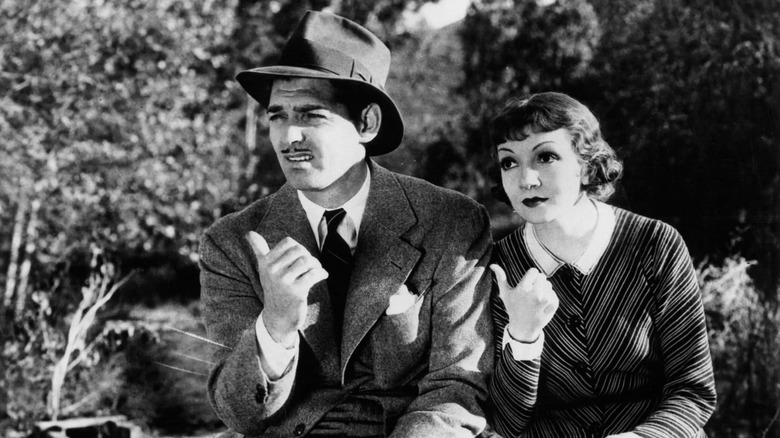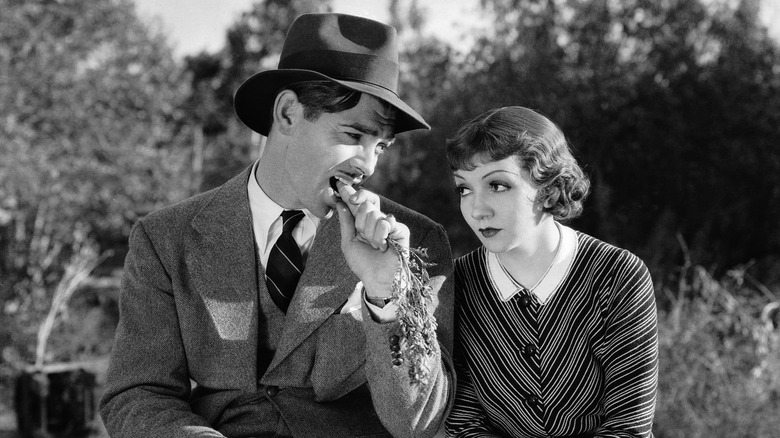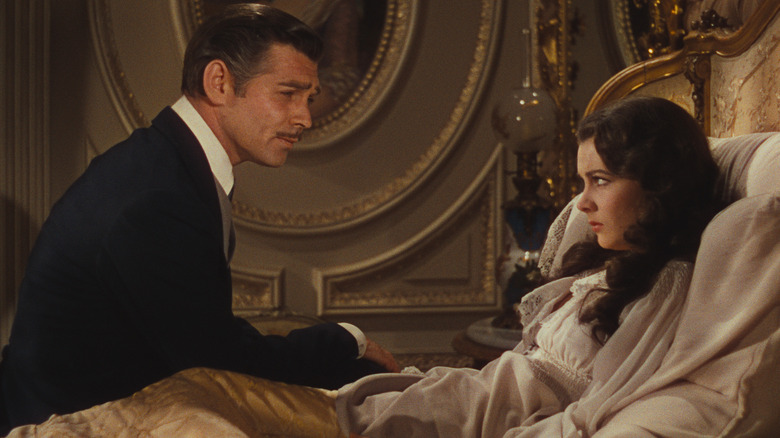Frank Capra Only Saw One Role As The 'Real' Clark Gable
Frank Capra's romantic comedy "It Happened One Night" was one of the most acclaimed films of 1934, and became the first film to win the "big five" Academy Awards: Best Picture, Best Director, Best Actress, Best Actor, and Best Screenplay. Indeed, the film was so influential that it more or less codified an entire genre. Since "It Happened One Night," most romantic comedies — and certainly any romantic comedies set on the road — have imitated Capra's film to one extent or another. It's a well-known piece of trivia that Bugs Bunny was inspired partly by Peter Warne, Clark Gable's character in the film, as he was a fast-talking wiseacre who, in one notable scene, humorously chomps on a carrot while chatting with Claudette Colbert.
Gable was a contract player at Metro-Goldwyn-Mayer, but was lent to Columbia Pictures for what was meant to be something of a "light" affair. "It Happened One Night" ended up becoming one of those Hollywood miracles that played by all the boring studio rules yet emerged on the other side, almost defiantly, as a legitimate classic. It's amazing that Capra assembled something so solid, and Gable plays a huge part in the film's enduring appeal.
Capra understood that Gable had untapped potential as a dazzling ne'er-do-well, feeling that none of his previous roles played to the actor's unique strengths. Gable's first leading role came only a few years previous with the 1931 pre-Code Joan Crawford crime drama "Dance, Fools, Dance," wherein he played a gangster. Most of his other early roles are in more serious crime dramas. It would take Capra to "unlock" Gable's talent as a romantic lead.
Clark Gable's early career
"It Happened One Night" was Gable's 22nd film as a credited actor (he was also an extra in several films in the 1920s). He came to prominence when overwrought melodramas were in fashion, and a look back over his work prior to 1934 reveals a slew of heavier films. He often starred opposite other rising stars like Joan Crawford and Jean Harlow (he and Harlow would share the screen in six films). An article in Commentary by Terry Teachout points out how absurd so many of these early roles were for Gable, most notably his part in Robert Z. Leonard's 1932 adaptation of Eugene O'Neill's "Strange Interlude," a heady, experimental drama about a woman who attempts to have a child by a man other than her possibly-insane husband. Gable played the "other man" opposite the resplendent Norma Shearer (the picture was originally meant to be a vehicle for the performing couple Fontanne and Lunt).
Gable was able to get MGM to lend him out to other studios, and it was Capra who thought to cast him opposite Colbert in what would be one of the biggest hits of the year. When Capra met with Gable for the first time, he saw that the actor had an untapped comedic persona not previously seen on the big screen. As quoted by Teachout, Capra felt that the Gable audiences saw in "In Happened One Night" was "[t]he real Gable. He was never able to play that kind of character except in that one film. They had him playing these big, huff-and-puff he-man lovers, but he was not that kind of guy. He was a down-to-earth guy, he loved everything, he got down with the common people."
The Clark Gable role
Gable has a famous scene in "It Happened One Night" in which he removes his shirt to reveal his bare chest. It may be apocryphal that nationwide undershirt sales apparently suffered as a result, but that speaks to the impact the film had on the culture. The role of Peter Warne solidified Gable in the minds of the public and gave rise to a "Clark Gable type" in subsequent movies.
Following Capra's film, Gable's roles took a shift. He began landing more romantic parts and racked up more Oscar nominations as well. Gable went on to star in the 1935 version of "Mutiny on the Bounty," the disaster film "San Francisco," and the aching romantic tragedy "Test Pilot." He also performed the standard "Puttin' on the Ritz" in Clarence Brown's frothy flick "Idiot's Delight." That same year, Gable would be chiseled even more deeply into the Hollywood firmament by playing Rhett Butler in Victor Fleming's slavery-era romantic mega-hit "Gone with the Wind," still one of the most successful films of all time (adjusted for inflation it's made $3.44 billion).
Today, Clark Gable is an archetype unto himself, the mold from which all other slightly caddish but ultimately vulnerable and charming romantic leads were formed. Capra understood where to put him, and a mass audience responded. For years, he was one of the biggest movie stars in the world. Gable continued to act throughout the late 1950s until his death of a heart attack in 1960 at the age of 59. He's buried at Forest Lawn in Glendale, CA.


